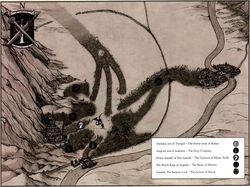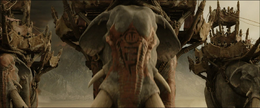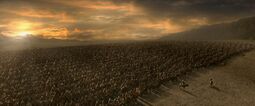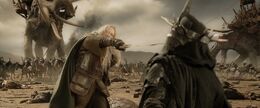
A map of the forces deployed in the battle
The Battle of the Pelennor Fields was a battle for the city of Minas Tirith, and ultimately for Gondor, immediately following a large-scale siege of Minas Tirith by Sauron's army. It was the greatest battle of the War of the Ring, and indeed the largest of the entire Third Age. Major casualties resulted from the battle, including the deaths of King Théoden and the Witch-king of Angmar.
History
Prelude
- Main article: Siege of Gondor
With Gondor's setback in the Battle of Osgiliath and the impending assault from Sauron's forces, Denethor was dismayed that Théoden did not come as quickly as he had hoped. Soon, despite the efforts of Faramir, the Rammas Echor was overrun, and the city isolated. The enemy began preparations for its attack, which commenced shortly and quickly pressed Minas Tirith greatly.[6]
The battle
Arrival of the Rohirrim
- "Arise, arise, Riders of Theoden! Fell deeds awake: fire and slaughter! spear shall be shaken, shield be splintered, a sword-day, a red day, ere the sun rises! Ride now, ride now! Ride to Gondor!"
- —Theoden's speech before the charge
Unknown to both Gondor and Mordor, the Drúedain secretly guided Théoden's army safely through the Drúadan Forest via an old, hidden road built by the Dúnedain long ago, and forgotten by all save the Wild Men. This allowed the Rohirrim to circumvent the defenses of the enemy on the northern road, and attack the forces of Mordor from the rear. Due to the dismantling of the walls of Minas Tirith, they could not mount a strong defense quickly, and Théoden's forces quickly overran the northern half of Pelennor. However, after forcing the retreat of the Haradrim cavalry, they were halted by the appearance of the Witch-king. He mortally wounded Théoden, who was crushed by his own horse Snowmane.[7]
At that moment, Éowyn and Merry Brandybuck rode up to face him. Éowyn smote the Fellbeast upon which he rode, and the Witch-king fell to the ground. He was unharmed by this, however, and he stood up menacingly, readying his mace. He swung at Éowyn, who managed to block the attack with her shield, which shattered under the great mace's force. Éowyn's arm was also shattered upon impact. She fell to the ground, and the Witch-king lifted his mace for a final blow. As he did so, Merry, who was behind him, stabbed him in the back of the leg with his Barrow-blade. The Witch-king was wounded, and Éowyn used this distraction to drive her sword into his face, killing him.
During this, and afterwards, the Rohirrim, under the command of Éomer, continued their assault, while the footmen of Gondor launched their own counterattack. Even so, they were outmatched by the Mûmakil, Haradrim, and Southrons, as the enemy committed their reserves. As the tide of battle turned against Gondor, the Men of the West were dismayed to see the Corsairs of Umbar had arrived.[7]
The final stage
Neither side knew that Aragorn and the Grey Company, with the help of the Army of the Dead, had vanquished the fleet of the Corsairs. The Army of the Dead repaid their debt to the King by driving the Men of Umbar upon the ships mad, causing them to jump off of their ships and drown. After loading the ships with as many men of Southern Gondor as possible, they sailed north to the battle. Upon arriving, the enemy found itself in a disadvantageous position, with their enemies where (and when) they least expected. The extra reinforcements brought by Aragorn punched a wide salient within the most vulnerable area of the Mordor-host, severing the forces nearer to Minas Tirith and the ones close to the river Anduin.
The Men of Gondor and the Rohirrim exploited this tactical advantage to the fullest, utterly routing the enemy with prolonged infantry charges and cavalry pursuit. The tactical and morale advantage granted by that was effective in turning the battle into a rout of the Mordor host. Most of the Mordor-host was slain and the rest fled back toward the Land of Shadow. A strong force of Easterlings fought to the last man, and Gothmog rallied many evil servants across the Pelennor to fight while other Orcs retreated. While they were decimated by the now numerically superior Armies of the West, Sauron's remaining army inflicted considerable casualties among their foes. The battle was over by sunset, with most enemies dead and a meager few fleeing.[7]
Losses

Mûmakil on the Pelennor
The Dark Host was lost all but completely. Few ever made it to Mordor, and fewer still survived of the Haradrim forces. However, they only represented a fraction of the forces of the Dark Lord. Most important to Sauron was the loss of his mightiest servant, the Witch-king. Although the numbers lost were not incredibly significant to Sauron, as he could afford to lose many times that of his enemies, the loss of his chief servant was a devastating blow. The losses of the West were significant as well. In addition to the lost commanders, it was said by Éomer later that not 4000 Riders were combat worthy, and the losses in other forces were probably considerable as well. However, despite that, with the newcomers from Southern Gondor and more arriving by prior order of Aragorn, even with all the losses of the battle and the 7000 heading for Morannon, the city was estimated to be better defended than before the battle, discounting the loss of the Gate.[8][9]
Portrayal in adaptations
Rankin and Bass
In the 1980 animated Return of the King film, the battle is only seen partway through. The men amongst Sauron's forces are never clearly seen, only the Trolls, Orcs, and integrated Uruk-hai. Exchanges of arrows between the two sides are seen, as well as melee battles. Some of the Mordor forces ride the towers lashed to the backs of the Oliphaunts. As the battle rages on, Pippin alerts Gandalf to the Denethor's despair. Denethor insists that the West has failed, and he wishes his end to be on his terms and not Sauron's. Gandalf protests, reminding him that Theoden's forces from Rohan are en route. But Denethor reveals his Palantír, and informs Gandalf that even that will be only a brief reprieve because the black fleet from Umbar is sailing upriver towards them. He then orders his servants in, to burn him.
(Note: Due to the censorship laws of the time the special had to dance around the fact that Denethor committed suicide, but Gandalf's "So passes Denethor, son of Ecthelion" line confirms his death all the same). Eventually, the forces of Mordor bring out Grond, towed into position by a team of Oliphaunts and operated by trolls. The Witch-king of Angmar arrives to direct the ram, borne to the fight on his Fell Beast. Gandalf and Pippin ride down to the gate to confront him. As Gandalf and the Witch-king duel with words, they are interrupted by a the crowing of a rooster, announcing the new dawn. The Horn of Rohan sounds in answer, announcing the arrival of the Rohirrim. They charge into the fray, cutting through Sauron's troops. The Witch-king retreats for the time being. Merry and Pippin are reunited in the fracas. As the fight progresses for days, the Dawnless Day arrives, overshadowing the field. During this the Witch-king returns filled with extra power, which spooks Snowmane and causes him to throw Theoden off to his death. Merry swears revenge. Éowyn challenges the Witch-king, slaying his mount and then dueling him. Merry distracts him with a well-timed stab to the buttocks, allowing Éowyn to slice off his invisible head.
Due to the film not having time for the healing-house scenes they are not rendered ill. The Mordor troops panic and start scattering, some throwing themselves into the river. Then the black fleet arrives, giving them fresh hope, only to dash it when the flagship raises not the standard of Mordor but the standard of the King of Gondor. They are thrown into complete disarray at this point and mopped up by the joint Rohan and Gondor forces. Aragorn and Gandalf then prepare for the march on the Black Gate.
The Lord of the Rings film trilogy
The Battle of the Pelennor Fields is featured in Peter Jackson's The Lord of the Rings: The Return of the King.

The arrival of the Rohirrim from the North
On the second day of the battle, with the forces of Gondor on the brink of defeat, the Rohirrim, with 6,000 fully armed horsemen, arrived at daybreak fresh and ready. After a stirring call-to-battle by King Theoden and a series of horn blasts, the legion of horsemen rode out as one towards Sauron's forces with the king at the apex. The orcs hastily reorganised themselves, setting up their pikemen in front and their archers behind them. As the Rohirrim closed in, the orcs opened fire with three volleys of arrows, killing several of the horsemen but it was all for naught as the barrage had no effect whatsoever on the Rohirrim's momentum. The Orc Chief could only look on in horror as the Rohirrim smashed headlong into the orc ranks with all the power and fury of a force ten times their actual size, slicing through and mowing down thousands of the panicking orcs with shocking ease. The orc lines buckled, splintered and then shattered completely, causing them to rout the field; yet the Rohirrim pursued them still, slaughtering the orcs by the hundreds.
Desperate to regain control of the battle, Sauron frantically deployed his reserve force; 20 Mûmakil each ridden by a force of 100 Haradrim. Though momentarily stunned by the sight of the intimidating animals, King Theoden reformed his forces and valiantly launched a counter-charge against the Haradrim. At first the Rohirrim suffered heavy losses from the tusks and trunks of the Mûmakil as well as the arrows and javelins of the Haradrim and floundered. Then, almost by accident, Eomer realised that the Mûmakil had a key weakness; their vulnerable drivers and confirmed this by killing the Haradrim king with a thrown spear, causing the Mûmakil he was controlling to swerve and crash into another Mûmakil, killing both animals. Using this, the Rohirrim were able to bring down several more Mûmakil but in the confusion, the orc forces regrouped and charged back into battle, threatening the Rohirrim even more.

Éowyn slays the Witch-king
As the battle raged on into the afternoon, The Witch-king joined the battle with his Fellbeast, attacking and mortally wounding King Theoden. Éowyn, who had ridden secretly into the battlefield as Dernhelm, threw herself in between her uncle and the black-clad wraith and retaliated with two mighty slashes on the Fell Beast's neck, decapitating the Fellbeast. Then the Witch-king and Éowyn engaged in a duel, with Éowyn narrowly evading two of his mace swings, and parrying one glancing blow. Spotting an opening, the Witch-King reversed his attack direction and countered with a devastating blow from his mace, shattering her shield and breaking all the bones in her arm. Just as Éowyn faced imminent death by the Witch-king, Merry stabbed the Witch-king in the back with his enchanted Barrow-blade, crippling the wraith and giving Éowyn an opportunity to plunge her blade into the center of the Witch-king's shrouded face, killing him.
Back inside the walls of Minas Tirith, the forces of Gondor prepared to make their last stand against the encroaching orcs. Out on the Pelennor fields, the Rohirrim continued to fight hard but were still heavily outnumbered and assailed from all sides. Then, just as defeat seemed imminent for Gondor and Rohan, the ships of the Corsairs of Umbar arrived on the river bank. A detachment of orcs arrived to join up with them but were instead greeted by the sight of Aragorn, Legolas, and Gimli jumping off the lead ship. The trio then charged the orc ranks, followed immediately by the forces of the Dead Men of Dunharrow, who poured onto the field butchering every orc and Haradrim in their path before flooding into the city itself and massacring every orc within. The remaining orcs and Haradrim stood no chance against the dead and were quickly slaughtered.
The battle ended with a grand albeit costly victory for the Free Peoples. Sauron meanwhile suffered his heaviest defeat to date; his primary orc armies had been completely annihilated, the Haradrim so badly mauled that they were no longer a threat and the Corsairs of Umbar were destroyed as a fighting force. Worst of all was the loss of his most powerful servant the Witch-King. Yet all was not lost for the Dark Lord, for though his Easterling allies were tied up in the Northern Theatre against the kingdoms of Erebor and Dale, Sauron still possessed large reserves of orcs in Mordor and was prepared to carry on the war for as long as was necessary. The Free Peoples meanwhile met to discuss a new strategy, giving way to the eventual march on the Black Gate.
Concept and creation
Sauron Defeated, the fourth volume of The History of The Lord of the Rings, part of the History of Middle-earth series, contains superseded versions of the battle. Some changes of detail are apparent: e.g. Théoden slain by a projectile to the heart instead of being crushed by his horse; or when Éowyn reveals her sex her hair has been cut short, a detail absent from the final version. Tolkien had also considered having Éowyn die.
There are repeated references by Tolkien to a historic account of the Battle of the Catalaunian Plains by Jordanes. Both battles take place between civilisations of the "East" and "West", and like Jordanes, Tolkien describes his battle as one of legendary fame that lasted for several generations. Another apparent similarity is the death of king Theodoric I on the Catalaunian Fields and that of Théoden on the Pelennor. Jordanes reports that Theodoric was thrown off by his horse and trampled to death by his own men who charged forward. Théoden also rallies his men shortly before he falls and is crushed by his horse. And like Theodoric, Théoden is carried from the battlefield with his knights weeping and singing for him while the battle still goes on.
Translations
| Foreign Language | Translated name |
| Afrikaans | Slag van die Pelennor Velde |
| Albanian | Beteja e Fushave Pelennor |
| Basque | Pelennorreko Zelaietako gudua |
| Belarusian Cyrillic | Бітва на Пеленорскіх Палях |
| Bosnian | Bitka kod Pelenorskih Polja |
| Bulgarian Cyrillic | Битката на Пеленнор полета |
| Catalan | Batalla dels Camps de Pèlennor |
| Chinese (Hong Kong) | 帕蘭諾平原之戰役 |
| Czech | Bitva na Pelennorských Polích |
| Danish | Slaget på Pelennorsletten |
| Dutch | Slag van de Velden van Pelennor |
| Esperanto | Batalo de la Pelennor Kampoj |
| Estonian | Lahing Pelennor Väljadel |
| Finnish | Pelennorin kenttien taistelu |
| French | Bataille des Champs du Pelennor |
| Galician | Batalla dos Campos de Pelennor |
| German | Schlacht auf dem Pelennor |
| Greek | Μάχη των πεδίων Πελεννορ |
| Haitian Creole | Batay nan tout Jaden Pelennor |
| Hausa | Yakin da Pelennor Filayen |
| Hebrew | קרב שדות פלנור |
| Hungarian | Csata a Pelennor Mezők |
| Icelandic | Orrustan við Pelennor Sviðum |
| Indonesian | Pertempuran Bidang Pelennor |
| Irish Gaelic | Cath na Páirceanna Pelennor |
| Italian | Battaglia dei Campi del Pelennor |
| Japanese | ペレンノール野の合戦 |
| Latvian | Kaujas no Pelennor Laukiem |
| Lithuanian | Mūšis Pelennor srityse |
| Luxembourgish | Schluecht vun der Pelennor Felder |
| Maltese | Battalja ta 'l-oqsma Pelennor |
| Norwegian | Slaget på Pelennor-engene |
| Persian | نبرد دشت پلنور |
| Polish | Bitwa na Polach Pellenoru |
| Portuguese | Batalha dos Campos de Pelennor |
| Romanian | Bătălia de la Domenii Pelennor |
| Russian | Битва на Пеленнорских Полях |
| Serbian | Битка код Пеленорских поља (Cyrillic) Bitka kod Pelonorskih polja (Latin) |
| Slovak | Bitka na Pelennorských poliach |
| Spanish | Batalla de los Campos del Pelennor |
| Swedish | Slaget vid Pelennors Fält |
| Turkish | Pelennor Çayırları Savaşı |
| Ukrainian Cyrillic | Битва на Пеленнор поля |
| Urdu | غزوہ پالانناور قطعات |
| Vietnamese | Chiến của các Trường Pelennor |
| Welsh | Brwydr y Caeau Pelennor |
| Yiddish | שלאַכט פון די פּעלעננאָר פעלדער |
References
- ↑ The Lord of the Rings, Appendix B: The Tale of Years (Chronology of the Westlands), "The Great Years"
- ↑ The Lord of the Rings, The Return of the King, Book V, Ch. III: "The Muster of Rohan"
- ↑ The Lord of the Rings, The Return of the King, Book V, Ch. III: "The Muster of Rohan"
- ↑ The Lord of the Rings, The Return of the King, Book V, Ch. III: "The Muster of Rohan"
- ↑ The Lord of the Rings, The Return of the King, Book V, Ch. II: "The Passing of the Grey Company"
- ↑ The Lord of the Rings, The Return of the King, Book Five, Ch. IV: "The Siege of Gondor"
- ↑ 7.0 7.1 7.2 The Lord of the Rings, The Return of the King, Book Five, Ch. VI: "The Battle of the Pelennor Fields"
- ↑ The Lord of the Rings, The Return of the King, Book Five, Ch. IX: "The Last Debate"
- ↑ The Lord of the Rings, The Return of the King, Book Five, Ch. X: "The Black Gate Opens"
